Types of Invasive Grasses in Lawns and How to Get Rid of Them

Just having weeds on your lawn is a pain. It is twice as challenging to get rid of them if they resemble grass, making them a bigger problem. These weeds, along with others like crabgrass, nutsedge, common couch, and others, provide a challenge that requires critical analysis on your part to resolve.
Crabgrass, nutsedge, quackgrass, clumping tall fescue, green foxtail, and annual bluegrass are examples of invasive plants that mimic grass. Some grassy weeds are hard to eliminate and may need to be treated with a selective pre-and post-emergent herbicide. Tall grass in a medium to tall grassy lawn can easily overtake part of the lawn until closely assessed. Herbicides that kill the grass family will destroy your weeds and lawn. This requires other processing methods described below.
10 Types of Weeds that Look Like Grass
1. Nutsedge
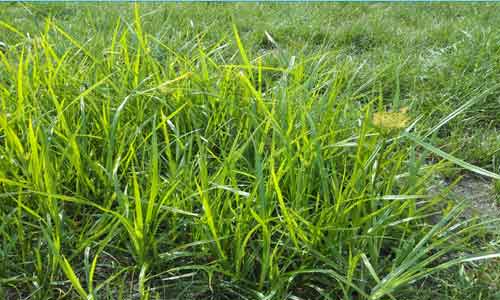
Nutsedge is another popular plant in our area that can be handled (though it is not very simple). This troublesome perennial likes wet spots on your lawn and may spread quickly in warm weather. Nutsedge may be difficult to manage once it has overtaken your lawn.
When it is new and undeveloped, it resembles tall grass. The main distinction between nutsedge and crabgrass—also known as nutgrass—is that the former is perennial, meaning it will survive for two seasons if allowed to flourish. This invasive grass spreads by both seeds carried by the wind and subterranean rhizomes/tubers. This explains why it may quickly reach lawns from surrounding fields.
How to Get Rid of Nutsedge
- Avoid removing nutsedge unless it is extremely early in the plant’s life cycle. If you do not, the tubers will shatter, producing further spread, or you will only succeed in plucking off the stems, which will cause the roots and tubers to develop more strongly the next time.
- It is better to start with thick grass to manage nutsedge before it spreads.
- You can apply a selective herbicide or pesticide such as epsom salt which is an effective weed killer if nutsedge is already present in your grass. Apply it directly to the base to destroy the entire plant, including the root system.
2. Smooth Bromegrass
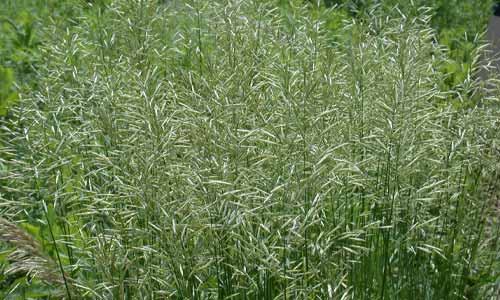
Due to its toughness, smooth bromegrass is a perennial grass-like plant that can be challenging to remove. The plant reproduces through rhizomes in the soil and a strong root system, in addition to being perennial and adaptable even to cold conditions.
Since it grows quickly and has a strong root structure, smooth bromegrass is more than just an annoyance; it also makes an excellent ground cover. Should you require it for this, it also makes excellent hay.
How to Get Rid of Smooth Bromegrass
- Since smooth bromegrass has a strong growth habit, it is recommended to establish a thick lawn right away. For greater efficacy, try this after mowing the grass.
- If smooth bromegrass is already grown in your lawn, treat the undesirable grass using weed and grass killers or herbicide.
3. Alexander Grass

A perennial plant that resembles St. Augustinegrass is called alexander grass, also known as tropical signal grass or creeping signal grass. If not removed as soon as possible, it would quickly choke off the most recent development of the grass due to its rather powerful growth.
How to Get Rid of Alexander Grass
- Herbicides cannot currently kill Alexandergrass. Therefore, the only option is to burn it off using baking soda before removing it and replanting that area of the grass.
- The only way to distinguish these weeds from grass is because they don’t resemble the grass on your lawn. However, in certain situations, they could appear grass on your lawn until they ruin it. So that you can see any weeds early on, always watch your grass to understand how it grows.
4. Tall fescue Grass

Tall fescue is a hardy plant that spreads through the soil by rhizomes and develops in large clumps. It can survive drought and most other situations that might damage your grass. Its fact, its leaves resemble stems from succulent plants. As a result, the grass will be swiftly crowded out and eliminated when it invades a lawn.
Tall fescue has the same potential for underground rhizome reproduction as some of the other species covered above. Tall fescue and Blue grass are well known used cold season grasses. Due to its excellent drought resistance, it frequently takes over areas where it has been planted, displacing other grass species.
How to Get Rid of Tall Fescue Grass
- Solarizing tall fescue is the best way to manage it. Solarizing requires covering portions of your grass for an extended period with an impermeable substance, such as nylon paper. This area lacks water, air, and sunlight and gets too hot for the plants to survive. They eventually disappear.
- Although weeds can be killed using herbicides, the amount needed to do so would be so great that the ecosystem would be harmed. Herbicides won’t be very affordable in terms of price.
5. Quack Grass
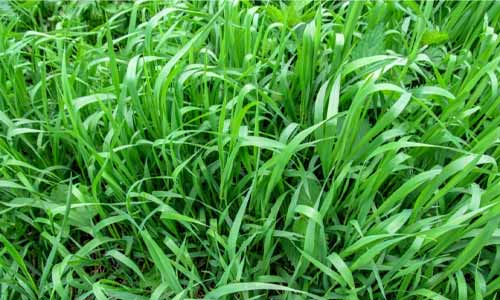
Quackgrass, often called “common couch” or “couch grass” resembles common grass, wheat and spreads by seeds and underground rhizomes. Consequently, once it’s formed, managing it becomes challenging.
How to Get Rid of Quack Grass
- To manage quackgrass, like the other invasive grass species on the list, it is better to establish a thick lawn early on. Invasive grass won’t have room to grow and spread since the desirable grass will crowd it out.
- Apply a targeted herbicide directly to the quackgrass if it is already established in your lawn to protect the surrounding attractive grasses.
- You’ll need to apply a herbicide directly to the weeds if they start to grow before your quackgrass is thick and strong enough to repel them.
6. Slender Rush Grass

Slender rush, sometimes known as “path rush” or “poor rush,” forms bunches similar to crabgrass. It is a brilliant green plant that resembles grass and spreads by both seeds on the surface and underground tubers. Due to these characteristics, it might still be fertile and ready to germinate even after using pesticides and uprooting as usual means of control.
How to Get Rid of Slender Rush Grass
- The best method for controlling this invasive species that resembles grass is usually manual weed management. Hand weeding may be necessary to do this. Take care to do this and obtain the root system as well.
- Herbicides and manual techniques like uprooting slender rush whenever it appears can be used to manage it. Always try to pull them out by the roots to stop them from coming back. Another strategy to stop them from reaching the seeding stage is to mow the lawn often.
7. Crabgrass

Crabgrass sometimes referred to as “finger grass,” is an annual invasive grass that looks similar to Bermuda grass. It spreads swiftly and may grow anywhere on your lawn, although it initially appears in tiny spots that eventually stretch into concentric rings.
Crabgrass has a rougher feel than other grass varieties. This might assist in separating it from the remaining of your grass. Crabgrass’s quick proliferation and long-lasting harm are its two main drawbacks.
This invasive grass will suffocate nearby plants if it is not managed. It is an annual plant with a coarser texture than most grasses. The fact that you can distinguish it from the rest of the grass thanks to these features, as well as the knowledge that it will expire after the growing season, is useful to you.
How to Get Rid of Crabgrass
- Preventing crabgrass from germinating is the best way to get rid of it. On your lawn, use a pre-emergent herbicide for this one. The majority of pre-emergent herbicides are mixed with fertilizer.
- On the other hand, if the crabgrass has already begun to sprout, you should take it out using a crabgrass remover individually or apply a direct contact herbicide. The greatest alternatives you have against this weed are these strategies, which will take some hard work on your side.
8. Green Foxtail Grass
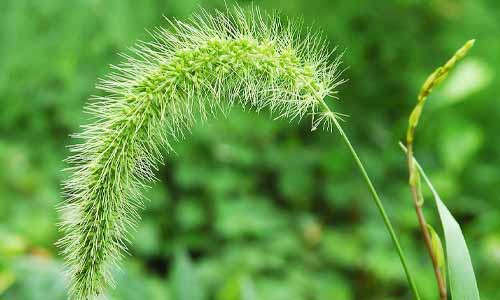
The stalks that grow on the crowns of this invasive grass give it the name “foxtail grass.” Green foxtails may reach heights of 4 to 40 inches and are commonly found in grasslands and meadows. The foxtails of the grass carry seeds, which may readily reach lawns and pastures and can disperse by wind over great distances.
These seeds, which may germinate at any time of year if the circumstances are right, are carried by each foxtail in large numbers (although they prefer warm soil around 59 to 95 degrees Fahrenheit).
How to Get Rid of Green Foxtail Grass
- The easiest way to tackle this plant is to have dense grass that will crowd it out. To avoid harming the nearby grasses, you can also use herbicides administered directly to the plant.
- Establishing dense grass from the beginning to control green foxtail is important. Invasive grass won’t have room to grow and spread since the desirable grass will crowd it out.
9. Wild Onion and Garlic Grass
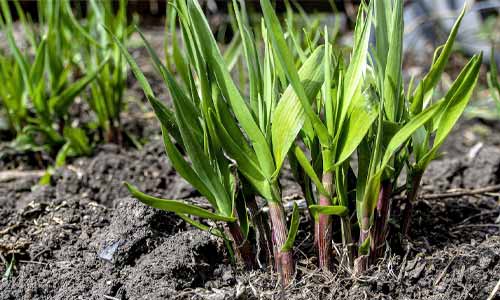
Because of how much it resembles onion and garlic plants, this invasive grass was given that name. They even have the same scent and may replace them in your meals! Wild onions and garlic resemble long grass on the outside.
After mowing, they have a distinct aroma that smells like freshly made spaghetti sauce and may be distinguished from other plants by this characteristic. They resemble tall grass in terms of appearance. They often grow more quickly than your lawn grass; thus, they will spread in clusters over the rest of the lawn.
How to Get Rid of Wild Onion and Garlic Grass
- One method of controlling them is to transplant them into your garden or a container so you can utilize them in dishes like onions and garlic. They are indeed wonderful and very much edible. Since they are dormant over the summer, they only grow in the early spring and late fall, making them simple to identify and manage.
- When the ground is moist, and you hold them in a big enough clump, you may uproot them with the tubers, which is also a good way to get rid of them.
- Additionally, herbicides may be used to control them. Because most pesticides don’t work on this specific weed, be sure to choose ones that do.
10. Annual Bluegrass

The invasive weed known as “Poa,” sometimes known as annual bluegrass, thrives in cold, damp settings and grows thickly. If possible, it would like to grow in regions with shade and ample water. The grass frequently dies in the summer or when the temperatures increase, and there isn’t enough rain.
This has both positive and negative aspects. It’s advantageous since the weeds will eventually disappear it is better to remove the weed using a weed eater, if you leave this weed alone in your lawn it’s harmful because when they do, your grass develops unsightly bare patches.
How to Get Rid of Annual Bluegrass
- This weed is quite simple to remove since you may crowd it out with a substantial lawn of your own.
- You may also destroy it by allowing the lawn to dry out somewhat since it needs chilly, damp conditions to thrive. You may dig it up, plant some healthy grass, and then water the area when it begins to shrivel.
- In cases when these approaches are unsuccessful, you can always turn to herbicides sprayed directly on the weeds.
Conclusion
Hope this guide on recognizing and removing 10 species of common invasive grass was helpful. Yes, the procedure can occasionally be exhausting, but when you’re left with a lush, attractive lawn, it’s well worth it. I hope you’ll read and understand 10 different types of Weeds that look like grass and how to get rid of them easily.






